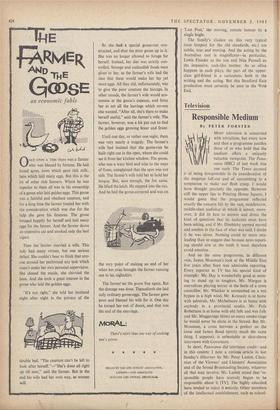Theatre
Grandma Osmosis
By BAMBER GASCOIGNE
The American Dream. (Royal Court.)—The One Day of the Year. (Theatre Royal, Stratford E.) loNEsco's is the style of theatre in which it seems to be hardest to tell the good from the trivial. This is true both of his own plays and of those of his followers. In The Birthday Party Harold Pinter made brilliant use of lonesco's brand of neurotic theatricalism, but the play was received with almost total scorn and closed even before the appearance of the Sunday papers. Now the English Stage Company has decided to present Edward Albee's limp effort, The American Dream; and it has been given a fairly good reception.
The American Dream contains all the most familiar lonesco moments: the opening se- quence with the wife chattering inanely to the taciturn, log-like husband; old friends failing to recognise each other; new arrivals forgetting why they have come; extreme reactions ('How fascinating!' HoW enthralling!') to obvious anecdotes; and the presence on-stage of numerous objects, in this case parcels of all shapes and sizes belonging to Grandma. These borrowings need not have mattered if Albee had not paraded them in such nudity. They are pre- sented almost without context, as clevernesses per sc. Albee is like a child who has taken Uncle Eugene's strange machine to bits, has washed and dried each component part and has then laid them all out on a clean tablecloth. So Grandma does nothing with her boxes except carry them for no apparent reason on to the stage and later cart them off again. Meanwhile she has even had the bleak effrontery to inform us that these boxes are her memories. By con- trast, in Ionesco's admirable play The New Tenant, where the objects acquired a genuinely rich symbolic value. they were treated by the characters merely as pieces of furniture.
Albee completes the double bill with another one-act play, The Death of Bessie Smith, which is much more successful. The famous blues singer died when a, white hospital in Memphis refused to treat her after a car crash. Albee doesn't so much dramatise this event as use it as a back- ground, a philosophical key to his drama. He creates in one of the nurses a central character who contains most of the elements which make such Southern atrocities possible. She is careful of her feminine dignity, yet ready to abuse any- one with the violence of a sergeant-major; she is alternately cynical and bigoted in her attitude to authority and tradition; she is capable of great charm and of even greater cruelty; she is coquettish and yet repressed. Gene Anderson gives a superb performance as this woman, who stirred in me more fear and hatred than any stage character for a long time past.
In one sense The One Day of the Year is a familiar problem-play with an Australian setting thrown in for novelty; the working-class student in. Sydney finds himself increasingly cut off from his family, yet., equally ill at ease in his new girl-friend's upper-class circles. But it is also more than this, because the author, Alan Sey- mour, avoids stereotypes and black-and-white issues. He has provided the perfect *arena for the family conflict—Anzac Day, when Aus- tralians parade in the morning and then booze until night to celebrate the gallantry of the `diggers' at Gallipoli. Father lives for this one day of the year; he loves the patriotic uplift and he loves getting drunk with his mates. Mother regards it as an annual ordeal, but a necessary one. Father's old friend, who was ac- tually at Gallipoli, views it with amused toler- ance, but without illusion. The son's girl-friend sees only the phoney gilding of war and the vomiting on the pavement. The son believes that he feels the same as her—and together they write a piece in the university paper, exposing the day's most sordid aspects—yet on the actual morning he still turns on the radio to hearthe 'Last Post,' the moving, remote lament by a single bugle.
The family's clashes on this very typical issue (respect for the old standards, etc.) are subtle, true and moving. And the acting by the Australian cast is magnificent—in particular, Lewis Fiander as the son and Nita Pannell as the impassive, rock-like mother. As so often happens in such plays, the part of the upper- class girl-friend is a caricature, both in the writing and the acting. But this Stratford East production must certainly be seen in the West End.















































 Previous page
Previous page